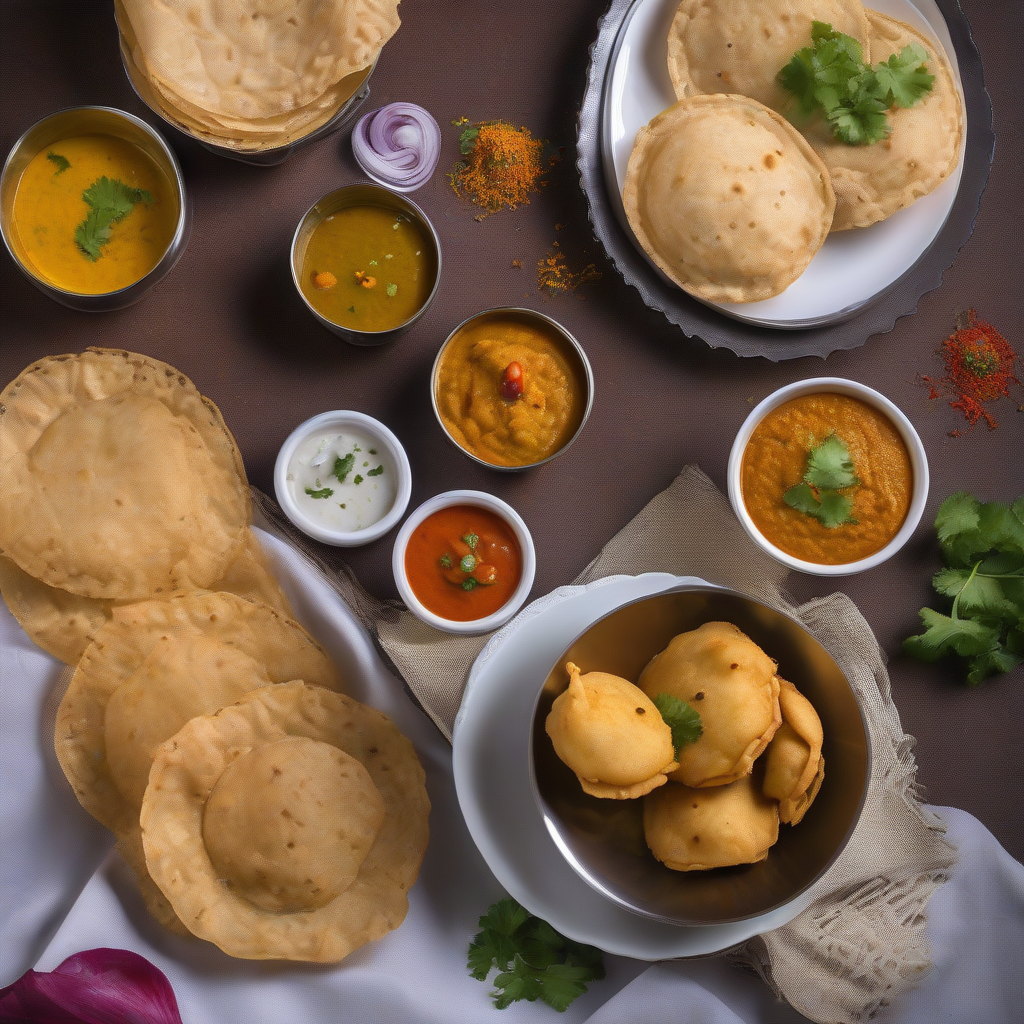Masala Poori: Ghar ka Pyaar, Har Bite Mein! (Love of Home, In Every Bite!)
Namaste Dosto! And a warm “Kem Cho?” to all my Gujarati friends out there! Chef Curry Do’pyaza here, back with another recipe that’s sure to tickle your taste buds and fill your kitchen with the most amazing aromas. Today, we’re diving into the world of Masala Poori – a delightful, spiced, and puffed-up bread that’s perfect for any occasion.
Masala Poori isn’t just food; it’s a feeling. It reminds me of joyous festivals like Diwali and Holi, where tables are laden with delicious treats. It’s the perfect snack for a long train journey, a picnic in the park, or simply a lazy Sunday brunch with family. In Gujarat, you’ll often find it enjoyed with a sweet and tangy mango pickle or a spicy chunda during the summer months.
A Little Trip Down Memory Lane
The humble Poori has been a staple in Indian cuisine for centuries. Its origins are somewhat shrouded in mystery, but it’s believed to have evolved from simple unleavened flatbreads. Adding spices to the dough to create Masala Poori is a clever way to elevate this classic, adding flavor and making it even more irresistible. My Nani (Grandmother) used to say, “A little spice makes everything nice!” And she was absolutely right!
Let’s Get Cooking!
Preparation Time: 20 minutes
Cooking Time: 25 minutes
Ingredients:
- 2 cups Gehun ka Atta (Whole Wheat Flour)
- 1/2 cup Besan (Gram Flour)
- 1 tbsp Adrak-Lahsun Paste (Ginger-Garlic Paste)
- 1 tsp Haldi Powder (Turmeric Powder)
- 1 tsp Lal Mirch Powder (Red Chili Powder) – adjust to your spice preference!
- 1/2 tsp Dhaniya Powder (Coriander Powder)
- 1/4 tsp Hing (Asafoetida)
- 1 tbsp Kasuri Methi (Dried Fenugreek Leaves), crushed
- 2 tbsp Tel (Vegetable Oil)
- Salt to taste
- Water, as needed
- Tel (Vegetable Oil), for deep frying
Instructions:
- Mix it Up: In a large bowl, combine the gehun ka atta, besan, adrak-lahsun paste, haldi powder, lal mirch powder, dhaniya powder, hing, kasuri methi, and salt. Give it a good mix to ensure all the spices are evenly distributed.
- Add the Oil: Add the 2 tablespoons of tel to the flour mixture. This will help make the pooris nice and crispy.
- Knead the Dough: Gradually add water, a little at a time, and knead the mixture into a firm, smooth dough. It should be tighter than your regular roti dough. Cover the dough with a damp cloth and let it rest for at least 15 minutes. This allows the gluten to relax, making the pooris easier to roll.
- Roll ’em Out: Divide the dough into small, equal-sized balls. On a lightly oiled surface, roll each ball into a small, round poori, about 3-4 inches in diameter. Don’t make them too thin, or they won’t puff up properly.
- Fry ’em Up: Heat tel in a deep kadhai (wok) or frying pan over medium-high heat. The oil should be hot enough to quickly puff up the pooris.
- The Puffing Magic: Gently slide a poori into the hot oil. Using a slotted spoon, press down lightly on the poori as it fries. This will encourage it to puff up beautifully.
- Golden Brown Goodness: Fry the poori until it turns golden brown and crispy on both sides. Remove it from the oil and place it on a paper towel-lined plate to drain excess oil.
- Repeat and Enjoy: Repeat the process with the remaining pooris. Serve them hot and fresh!
Tips for the Best Masala Poori:
- Don’t Over-Knead: Over-kneading the dough can make the pooris tough. Knead just until the dough comes together and is smooth.
- Hot Oil is Key: The oil must be hot enough for the pooris to puff up properly. If the oil isn’t hot enough, the pooris will absorb too much oil and become soggy.
- Press Gently: Pressing down gently on the poori as it fries helps it to puff up evenly.
- Fresh is Best: Masala Pooris are best enjoyed hot and fresh. They tend to lose their crispness as they cool down.
Cooking Variations:
- Gas Stove: The traditional method, as described above, is perfect for a gas stove.
- Induction Stove: You can easily use an induction stove with a suitable kadhai or frying pan.
- Air Fryer: While not traditional, you can “bake” the pooris in an air fryer for a healthier option. Lightly brush the pooris with oil and air fry at 375°F (190°C) for about 5-7 minutes, flipping halfway through. They won’t puff up as much, but they’ll still be tasty!
- Oven: Similar to the air fryer method, you can bake the pooris in a preheated oven at 350°F (175°C) for about 10-12 minutes, flipping halfway through.
Nutritional Information (approximate, per poori):
- Calories: 120-150
- Fat: 6-8g
- Carbohydrates: 15-20g
- Protein: 2-3g
Note: Nutritional information may vary based on specific ingredients and portion sizes.
Serving Suggestions:
Masala Pooris are incredibly versatile! Here are a few of my favorite ways to enjoy them:
- With Aloo Sabzi (Potato Curry): A classic combination that’s hard to beat.
- With Chole (Chickpea Curry): A hearty and flavorful pairing.
- With Shrikhand (Sweet Yogurt Dessert): A sweet and savory delight, especially popular in Gujarat.
- With Mango Pickle: The tangy and spicy pickle complements the savory pooris perfectly.
- As a Snack: Enjoy them on their own with a cup of chai (tea).
Time to Cook!
So there you have it, folks! My recipe for delicious, homemade Masala Poori. I encourage you to try this recipe at home. It’s a wonderful way to connect with your culinary roots and share the joy of Indian cuisine with your loved ones. Make them for your family, pack them for a picnic, or simply enjoy them as a tasty snack. Let me know how it goes!
Happy Cooking, and remember, Khana Khao, Khush Raho! (Eat Well, Be Happy!)
